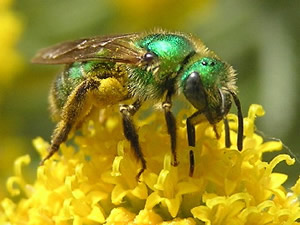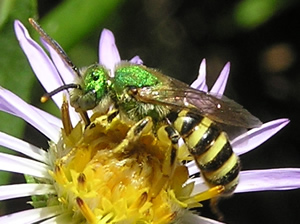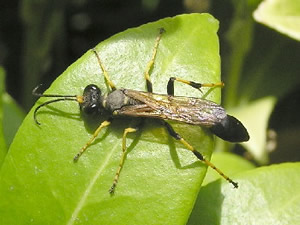| |
|
| |
Handy Guide to Bugs: Hymenoptera - Bees, Wasps, Hornets and Ants |
| |
The bugs belonging in the order Hymenoptera all have very narrow "waists" which allow them to freely move the back ends of their bodies so they can sting or lay eggs.
In the picture on the right of a Yellow-legged Paper Wasp, Mischocyttarus flavitarsis, you can clearly see this body structure. |
|
 |
|
The insects in this order can be both a pain and a pleasure. Many a picnic has been wrecked by wasps buzzing around or an invasion of ants. However these insects play very important roles in nature - these bugs are all busy bugs.
"Hymenoptera" means "membrane wings" in Greek and refers to the fact that most insects in this order also have four transparent wings. The two smaller back ones are attached to the larger front ones.
|
The Bees
Bees are small in size (2-4 cm) and have hair which help them collect pollen, in fact they are the most important group of pollinating insects. They also have a sting to protect them. Bees sometimes look like wasps, but have more hair and thicker bodies. The majority of bees live by themselves but the most famous ones - the honeybee and bumblebee live in colonies. |
|
Western Bumblebee, Bombus occidentalis |
| |
|
| |
|
|
|
Sweat Bee, Agapostemon sp |
|
Sweat Bee, Agapostemon sp |
| |
|
| |
|
|
|
Metallic Green Bee, Agapostemon texanus |
|
Metallic Green Bee, Agapostemon texanus |
|
|
| |
|
The Wasps
Wasps don't have the hairs that bees have. They too have species which are solitary and others which are social living in huge colonies. Adults feed on nectar, fruit and plant sap.
|
|
|
Potter Wasp |
|
Mud Dauber Wasp |
| |
|
| |
|
|
|
Chalcid Wasp, Leucospis sp. female |
|
|
|
The Hornets
Hornets are considered to be large wasps. They have dark brown and yellow stripes all over their bodies. They make the largest nests which are insulated with layers of "paper" - chewed up plant material mixed with saliva. |
| |
|
|
|
Bald-faced Hornet |
|
Blackjacket |
|
|
| |
|
Links at the Inn:
At-A-Glance Guide to Bees and Wasps |
| |
|














